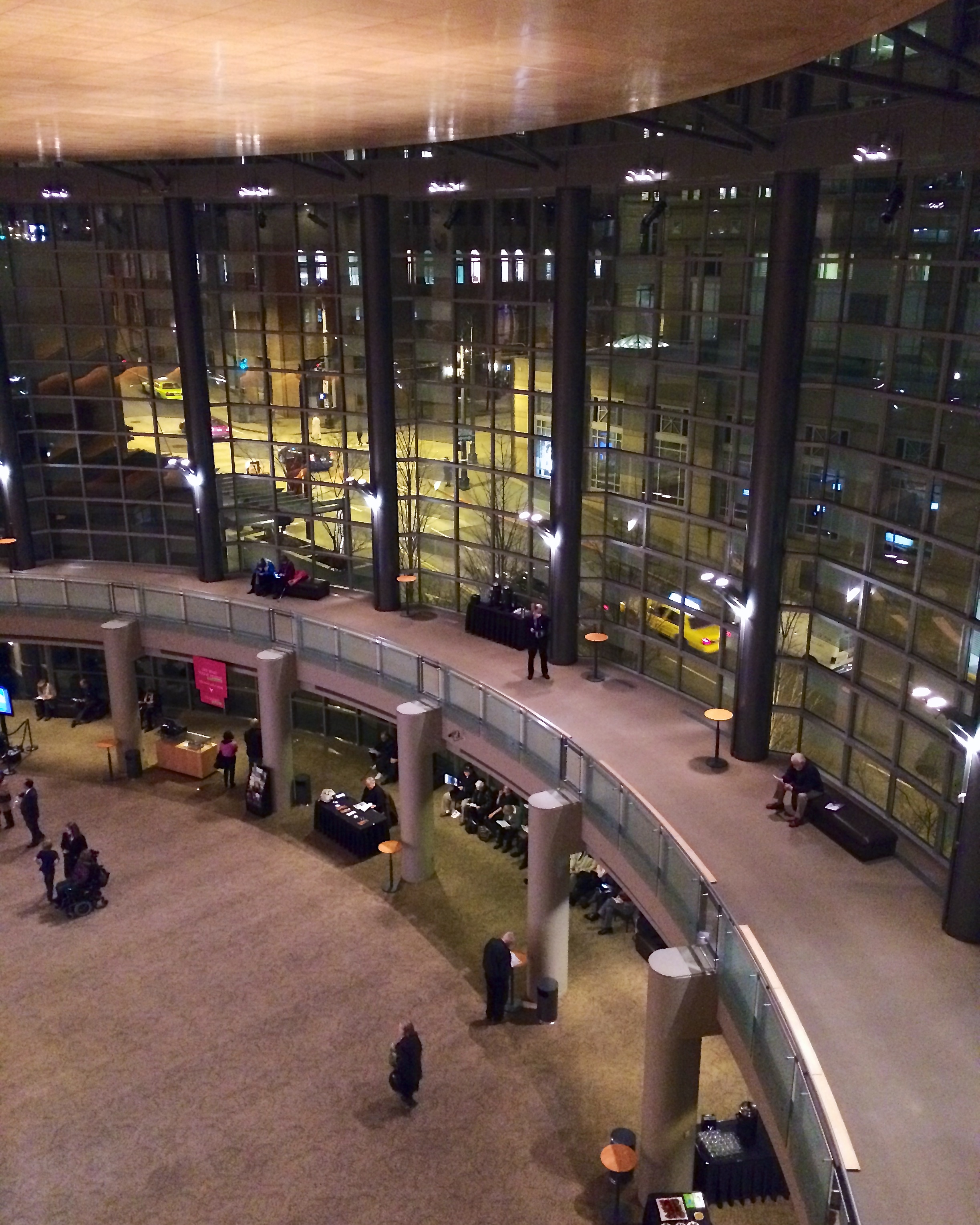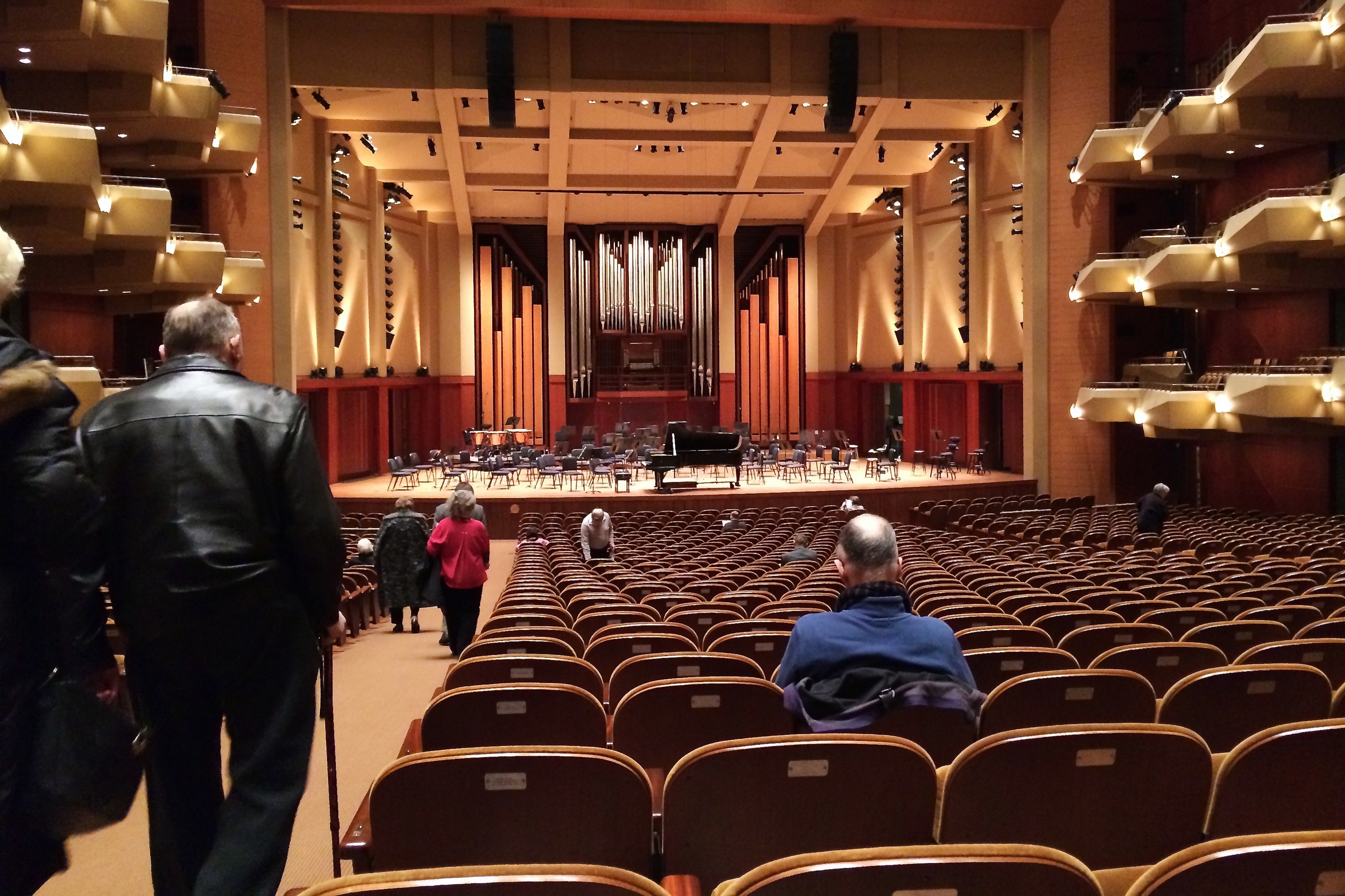TchaikFest!
Melody and I had a gift certificate to the Seattle Symphony. Given the opportunity, we looked through the schedule and decided to go to the performance of Tchaikovsky's first two piano concertos, part of “TchaikFest!”
There was a second TchaikFest! concert the next day which included the third piano concerto and the violin concerto.
Before the concert we grabbed dinner, going a bit early knowing the pre-concert crowd would create lines. Sure enough, we had no wait, but there were a couple dozen people in line as we were finishing up.
We went into Benaroya Hall quite early, almost a half hour before the hall was opened. We took the opportunity to wander around, going to the highest levels to take in the view of the lobby. There was also a collection of photographs by Lara Swimmer which were taken during the construction of Benaroya. It was interesting to see the vibration dampening going in, as well as the box seats going into the hall before it was enclosed.
Having grabbed a program, we found our seats. They were pretty far back, but fortunately Benaroya has great sound, so we knew that while we may not be able to see as well, we would hear everything just fine. As per usual, we perused the program notes as others were getting settled.
A couple years ago, Gerard Schwarz stepped down as Music Director and Ludovic Morlot took his place. We haven't seen Morlot conduct yet, and TchaikFest! would not present the opportunity for us. Instead, the conductor was Carlos Miguel Prieto, the director of the Louisiana Philharmonic. After the orchestra did their final tuning, he and the first pianist stepped onto the stage and the concert began.
Piano Concerto No. 2 in G major, Op. 44
The first soloist was Boris Giltburg, who was very solid and technically excellent. As per usual, the audience did applaud after the first movement, and I found it interesting that he chose to keep looking forward. I've seen several pianists acknowledge the audience without standing, turning their head outward and nodding.
Neither Melody nor I are very familiar with the second concerto, and we found the first movement had what seemed to be several themes. At one point I heard what I at first thought was the cadenza (where the pianist does a solo towards the end of a movement; it's also an opportunity to personalize the piece by using a different cadenza) but the solo was very long, and ends up the cadenza was later on.
The second movement included cello and violin solos. The concertmaster stayed in his seat, but the solo cellist moved around to a chair on the keyboard side of the piano. However, when her solo parts were done, she moved back to her normal chair, doing the switch before the end of the movement.
The third movement certainly got the audience excited, as it was very stirring. Giltburg got a standing ovation (which is almost automatic at Benaroya), came out to take his bow, then came out again with Prieto to take a bow with the orchestra. He came out a third time to do an encore, which neither of us recognized.
Piano Concerto No. 1 in B-flat minor, Op. 23
After intermission, Prieto came out again, this time with Alexander Lubyantsev, who had the daunting task of playing a piece that we (and, I would guess, a good portion of the audience) know quite well.
The first thing that struck me is Lubyantsev has a style of playing which reminded me of Mr. Voorhies, which was to have very calm arms and body, making everything look effortless. For example, when playing the opening chords, I'm used to seeing people arcing their hands between chords, as if skipping stones. Lubyantsev, however, would play a chord, moving his hands over to the next chord raising them less than an inch from the keyboard, wait a beat, then play the next chord. He obviously has a great deal of finger strength. The second thing that struck me was that he seemed to have large hands, looking at how his fingers were moving.
Like Giltburg, Luyantsev was very solid and we had no worries about whether he would miss notes (although, strangely enough, he did, but he was extremely smooth recovering from it). Again, the audience applauded after the first movement. However, this time Prieto waited quite a while for the audience to settle down (even having the orchestra putting down their instruments for a few seconds). It was nice that he did, since the second movement starts out so quietly.
The third movement is very exciting, and the final note didn't have time to fade away before the audience had jumped to their feet. The same routine of curtain calls ensued, but this time after the orchestra bowed, Prieto didn't let Luyantsev walk off the stage, instead indicating that he should go straight for his encore before the majority of the audience left. After the encore, another standing ovation, and a second encore followed. After that one, when Luyantsev came out for the second curtain call, he went towards the piano, seemingly asking the audience if they would like to hear something else. The response encouraged him to proceed, which he did. Melody and I again didn't recognize the pieces, but were wondering if they were pieces he arranged or composed.
Observations
Here are some things I noticed during the concert.
There are plenty of announcements to turn off electronic devices and that photography isn't allowed. However, I did see someone take a photo, noticing because it was a flash photo. I also heard a phone; that's better than other concerts when I've heard several phones.
Prieto was a very enthusiastic conductor. He eagerly hugged each soloist, including the cellist. I also saw that during some of the most exciting parts, he actually jumped off his riser. It seemed too bad that he was hidden behind the piano lid for the whole concert.
During intermission stagehands moved the piano off the stage and brought another one out. Seems like the two artists chose different instruments to use. I wonder how many they have available.
An older couple sat in front of us, and they were extremely cute. The husband had trouble moving around, relying on a cane. However, he was on the end seat, so he needed to stand several times as people went in and out. He did it with good humor, however. During the concert he would nod off every now and then; the wife would place her hand on his knee and he would wake up.





